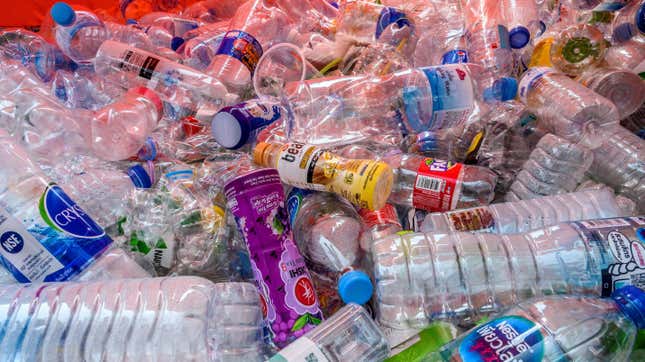
Coronavirus is Earth-shatteringly scary, and social distancing sucks. To distract myself and pull my brain out of the depths of speculative despair, I’ve been drinking a ton of seltzer, mostly from plastic bottles. I know that’s bad because plastic is an environmental nightmare, but seltzer water gives me more pleasure than many other things, so I keep doing it. Well, surprise! My plastic-bottled-seltzer habit may be even worse than previously thought, because of our good friend microplastic pollution.
Microplastics, or pieces of plastic measuring less than 5 millimeters, are so small that they can pass through sewage treatment plants and leech into bodies of water, where they release toxins and pose dangers to marine life. They also drift into the air, where they can be toxic when we breathe them in. They’re generally thought to come from larger plastic items breaking down over time or from manufacturers directly creating them (that’s why those teeny little exfoliating microbeads are so bad).
But a new study, published in the journal Scientific Reports on Thursday, located another major source of these materials—my fucking Perrier bottles. That’s right: Just opening soda bottles, snack packages, or sealed wrapping material can generate microplastic pollution.
Using spectroscopes, chemical tests and microscopes, scientists observed how much of this pollution was created by ripping open chocolate the generation of microplastics while tearing open chocolate packaging, cutting through sealing tape with scissors, and twisting off plastic bottle caps. They found that for every 30 centimeters (about one foot) of plastic torn, 1 to 3 nanograms of microplastic—or 1,400 to 7,500 microplastic pieces—was created. For scale, one bottle of an exfoliating product can contain 300,000 microbeads, so this may not seem like a huge amount of plastic waste. But the scale at play here makes this a huge issue: Eliminating microplastic pollution from opening all kinds of plastic packages would require changing nearly every kind of manufacturing.
The scientists call for more research to determine the specific risks associated with this form of microplastic pollution. “Possible toxicity and how they may be ingested are not yet resolved and further research into human exposure is needed,” they say in a release.
The study is one more sign that we need to move away from using single-use plastic packaging altogether, and there are folks fighting to make that a reality. The entire European Union is planning to ban single-use plastics by 2021, and last month, for instance, Senator Tom Udall(D-New Mexico) and Representative Alan Lowenthal (D-California) put forth a federal bill to ban the production of some kinds of plastics, put a moratorium on permitting new plastic production facilities, and force large, polluting corporations to manage and pay for recycling programs.
But even though folks are hard at work to phase out of plastics, honestly, this is still stressing me out. It’s way too early for beer, so I’m gonna go grab another Perrier, brb.

